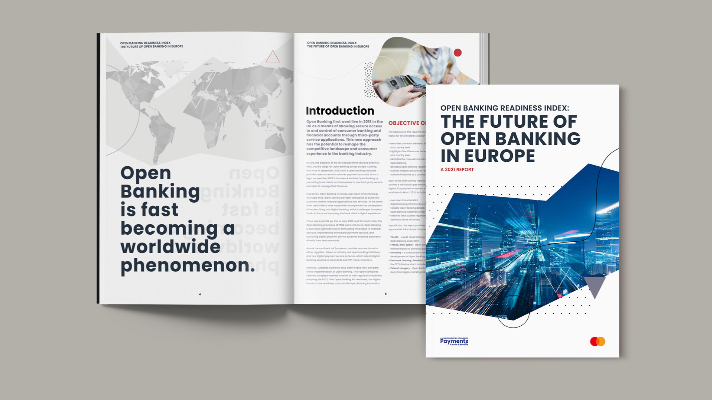UK and Nordics lead Open Banking in Europe. „We need greater standardisation” – Mastercard says.

In the UK there are more than 100 live solutions already in market and Q1 2021 usage exceeded 2bn API calls for the first time. By early 2021, more than 3 million UK consumers and businesses used open banking enabled products to manage their finances, access credit and make payments. Payments API volume in the UK increased by more than 70% between Q1 2021 vs Q4 2020.
According to a new report by Mastercard, which conducted in-depth research into how prepared European countries are to embrace the open banking ecosystem, the Nordic countries have been crowned best placed to take advantage of it, together with the UK.
Open banking is fast becoming a worldwide phenomenon. It empowers consumers and businesses to take control of their financial data and their financial futures while stimulating competition and innovation among financial service providers. The report – ‘Open Banking Readiness Index: The Future of Open Banking in Europe’ – found the Nordics’ and UK’s digital infrastructures ensure the countries are very well-placed to allow widespread use of this concept:
. Households with internet access: 95% Denmark; 98% Norway; 96% Sweden; 96% UK
. Per cent of mobile phones which are smartphones: 88% Denmark; 95% Norway; 79% Sweden; 83% UK
. Proportion of 14-76 year old using digital banking: 91% Denmark; 95% Norway; 84% Sweden; 88% UK
The UK is building a world-leading open banking digital ecosystem with its own framework and API standard. According to The Open Banking Implementation Entity (OBIE), which was set up by the UK Competition and Markets Authority (CMA) in 2016 to deliver Open Banking, around 294 fintech companies and payment service providers have joined the open banking ecosystem in the UK, of which 102 have live offerings in the market.
The pan-Nordic collaborative models and P27 initiative aid the region’s open banking readiness and most of the big Nordic Banks have an open banking strategy, with Nordea Group and DNB Bank among Europe’s frontrunners. Norway also has digital customer identification services such BankIDs and Invidem, which add security by proving an individual is who they claim to be and are strong examples of how the Nordic countries are leading the way.
Jim Wadsworth, Senior Vice President for Open Banking, Mastercard, said: “By taking advantage of pan-European developments such as PSD2, all European banks are progressing towards a full open banking environment, but it is clear the UK and Nordics are leading the way with high consumer readiness and a number of solutions already live.
“There are varying approaches across the continent and to ensure that all European markets can take advantage of the opportunities that open banking presents, we need greater standardisation. Mastercard Open Banking Connect provides a universal connection to financial institutions’ open banking functionality, providing third parties with scale, resilience and speed.”
Banking solutions live in the UK include allowing customers to view balances and transactions from other institutions on a single screen, and personal finance management apps such as Cleo, Plum and Moneybox, which help people budget and save more easily.
The Nordic countries are also well placed for open banking in terms of consumer readiness as Norway boasts the highest internet penetration, with 98% of households connected. And, at present, the UK Open Banking model does not include a digital ID authentication service scheme and domestic KYC utility services (such as the Nordic BankIDs and Invidem solutions).
The report also highlights the key differences in how countries are approaching open banking:
France, Italy, Spain – open banking is being used as a vehicle for digital transformation in domestic payment ecosystems.
Germany – a collaborative approach, specific to Germany, is being taken for the development of open banking.
Denmark, Norway, Sweden – the Nordic collaborative models and P27 initiative aid the region’s open banking readiness.
Poland, Hungary – open banking is being used as vehicle for leapfrogging away from legacy banking infrastructures.
The picture across Europe is generally promising on the whole, with all ten countries reviewed making progress in key areas. To access the full Open Banking Readiness Report, visit: openbanking.mastercard.com/readinessindex, and look out for registration details of Mastercard’s Open Banking Readiness webinar which is scheduled for July 12th.
______________
Methodology: The report explores the status of open banking in ten selected European markets, examining each country’s regulatory regime’s adoption of PSD2, the stability and readiness of their APIs, open banking account-to-account (A2A) payment innovation, and – importantly – the readiness of the local population in terms of internet access and e-commerce behaviours.
Dariusz Mazurkiewicz – CEO at BLIK Polish Payment Standard
Banking 4.0 – „how was the experience for you”
„To be honest I think that Sinaia, your conference, is much better then Davos.”
Many more interesting quotes in the video below:











